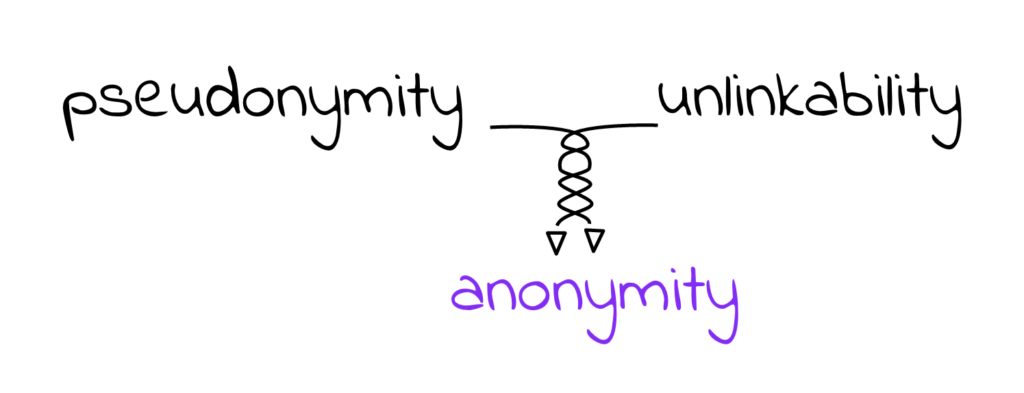Blockchain is redefining the evolution of finance and application creation. Unlike the central formed systems that govern us today, this technology introduces innovative approaches that shape new financial infrastructure, allowing users to dictate the direction of each project, wielding the power to all users.
Public blockchains operate according to these standards. However, while blockchains like Bitcoin and Ethereum excel at distributing power to the mass, their current public-by-default designs will likely not provide the maximum privacy we are all striving for.
This lack of user privacy stands out starkly in the modern age of surveillance capitalism and the transparency of the public blockchains may only feed into these existing concerns even more. Their ability of end-to-end surveillance on every financial transaction for each wallet creates usability challenges that may limit the level of privacy and adoption they can offer.
Think of it as you are sharing the information required for bank transactions.
Your bank card number is your public key. Once two people transact on the blockchain, they know each other’s public keys and can track the accounts associated with the person from then on. In simple words – once you know someones public key, you can know all of the owners’ purchases…
Should our purchase of every coffee or premium account be public knowledge?
Do we want all of our personal data easily available to centralized databases?
The radical transparency offered by public ledgers turns to be a significant hurdle to the mass adoption of crypto for payments – as well as a huge security risk. Privacy solutions within crypto haven’t kept up with the rate of application development and user growth as we would wish.
Privacy is far from assured on the blockchain. Transactions are at best pseudonymous (not anonymous), which hackers attacks often realize at their expense.

It is important to distinguish anonymity from privacy.
In the case of privacy, users’ address stays public and everyone can see what you did but not the transaction data itself. This solution enhances the traceability of illegal activities and is preferable for mass adoption.
Anonymity coins Monero and Zcash use complex cryptography to obfuscate transaction details, preserve users’ privacy and increase security. With cryptocurrencies like these, users address remains completely hidden, making the transactions anonymous. But they fall short in meeting the demands of DeFi and Web3 users since neither support smart contracts, creating a gap in the market.
Networks are being developed with the aim to fill that void.
Cosmos
The vision of Cosmos is to make it easy for developers to build blockchains and break the barriers between blockchains by allowing them to transact with each other. The end goal is to create an Internet of Blockchains, a network of blockchains able to communicate with each other in a decentralized way. With Cosmos, blockchains can maintain sovereignty, process transactions quickly and communicate with other blockchains in the ecosystem, making it optimal for a variety of use cases.
This vision is achieved through a set of open-source tools like Tendermint, the Cosmos SDK and IBC designed to let people build custom, secure, scalable and interoperable blockchain applications quickly.
If you want to find out more about Cosmos – read our article.
So, what is Secret network?
Secret Network is a Layer 1 solution built with the Cosmos SDK, leveraging proof-of-stake (PoS) using Tendermint’s Byzantine fault-tolerant consensus algorithms. The native token of Secret Network is “SCRT” and it is not a privacy coin. Computations are performed by each node on the network for verifiability, security, and consensus purposes. Due to being a Layer 1 solution, Secret Network is chain-agnostic and capable of interoperability with a range of networks using the Cosmos InterBlockchain Communication protocol (IBC). To achieve data privacy, the Secret Network protocol leverages key management, encryption protocols, and Trusted Execution Environments (TEE) that are part of the hardware specification for all validator nodes of the network.
TEEs are used in many devices, including smartphones and video game consoles, and act as a “black box” for computing encrypted data. Secret Network TEEs maintain the integrity of any encryption layer, which ensures transaction data remains secure and private during execution, even to validators. The only way to view encrypted information is through a set of “viewing keys.” End-users have full control over these keys, which gives them access to private transaction details so that they can share with let’s say, tax authorities. TEEs guarantee that nodes are unable to view computations that occur within the trusted environment – preserving the privacy of the underlying data during the computation. The underlying ledger of Secret Network is publicly visible; the token (SCRT) is used for governance, transactions, and gas fees. The protocol implements programmable privacy, which is defined as arbitrarily complex data privacy controls within Web3 applications:
Secret Bridges
One of Secret Network’s key developments has been connecting to other networks with existing user bases and liquidity pools. The Secret Network leverages the Secret Bridges to enable holders from different ecosystems to mint Secret Tokens on its network. As its name implies, Secret Bridges connects the Secret Network with other blockchain networks. It can share the activity generated by other blockchains without spending excess resources building a new economy but building bridges. By now (November 2021) Secret Network has deployed bridges to Binance Smart Chain (BSC), Monero, to Plasm/Astar Network (Polkadot), as well as a bridge to the fast-growing Terra ecosystem.
Secret DeFi
Decentralized Finance is one of the obvious sectors that can benefit from privacy. For example, with the help of secret contracts, DeFi (decentralized finance) lending app can autonomously give out loans to users, without the need to expose all of their transactions publicly.
SecretSwap is Secret Network’s response to popular DeFi platforms such as Uniswap and PancakeSwap. It is a cross-chain decentralized exchange that runs on the Secret mainnet. It offers many of the same features that other DEXs do and has more still to come. Fees on SecretSwap are paid out in SCRT, which provides significantly lower fees than Ethereum currently does.
One handy feature is the Ethereum bridge, which allows exchanging Ethereum for SCRT and vice versa. Support for other bridges is also in the works, including the Binance Smart chain and Monero bridges. From there you can dive into liquidity providing, swapping, or staking.
$SEFI ( short for Secret Finance, that rhymes with DeFi) is a newly presented native governance secret token for Secret DeFi that allows users to govern parts of the Secret DeFi ecosystem in a decentralized fashion such as:
- Spending the SEFI development pool;
- Determining pools eligible for user rewards, including changing their respective weights;
- Joining other communities, for example, by enabling joint liquidity mining campaigns like Sushiswap Onsen;
- SecretSwap fees and use of fees;
- Adding other products into Secret Finance that receive and utilize SEFI
Secret NFT
Even though the NFT craze is slowing down a little, they recently announced progress on Secret NFT support. Secret Network’s privacy properties can extend to multiple token types, including NFTs. Secret NFTs are a new asset class of non-fungible tokens, enhanced with privacy and access control features to create hidden content and experiences. In April 2021, the recipient of the network’s first community grant unveiled a reference implementation on mainnet for a Secret NFT standard (SNIP-721). Like its fungible counterpart, Secret NFTs inherit the same privacy characteristics when being transferred or processed by Secret contracts. Secret NFTs have the same characteristics as Ethereum’s ERC-721 tokens as well as offer three new features:
- the ability to hide ownership of scarce items;
- privatize the metadata field (how an NFT signature connects to off-chain data like art);
- control access to the connected content
These properties may enable new NFTs use cases (game items with hidden abilities or art embedded with secret links) and allow artists or marketplaces to customize access to their product (important for exclusive events or the adult entertainment industry). An example of a cool Secret NFT project is the new upcoming’s Tarantino NFT Collection. 🙂
Oasis Network
The Oasis Blockchain Platform is a Layer 1 Proof of Stake (PoS) smart contract platform that provides scalability, extensibility and privacy. The main features of the platform enable efficient verifiable and confidential smart contract execution. The modular design of the platform allows the consensus layer to be easily changed, meeting the benefits from the latest progress of the technology. Furthermore, the platform runs multiple independent smart contracts runtimes simultaneously called “ParaTimes”. This greatly improves scalability for smart contracts, since the computing costs for a desired level of security is reduced. Oasis’s modular layer design makes this possible as it separates smart contract execution from consensus, which allows the reduction of the replication factor without sacrificing security.
Having two distinct layers also allows ParaTimes to be easily customized depending on the computation needs of particular use cases for the network. This means larger more complex workloads can be processed in parallel to smaller, faster transactions without slowing down the entire network. The architecture does not require the use of “discrepancy detection” and ParaTime implementers can choose to use different verifiable computing technics for smart contract execution such as multiparty computation (MPC); fully homomorphic encryption (FHE); zero-knowledge proof (ZKP) etc.
The platform also provides private computation using Trusted Execution Environments (TEE) for efficient, cost-effective private smart contracts execution, creating more secure and favourable conditions for mass adoption of DeFi applications and blockchain.
Stage of development of the Oasis Network
- Nov 2019 — Public Testnet
- Jun 2020 — Amber Network
- Oct 2020 — Mainnet (Beta)
- Nov 2020 — Mainnet (Production)
Tokenized data
Its unique privacy features can not only redefine DeFi and revolutionize open finance but also create a new type of digital asset called Tokenized Data that can enable users to take control of the data they generate and earn rewards for staking it with applications. The aim is to create a more “responsible data society”. This technology combines two foundational elements: the public and easily shareable nature of tokenized data, with secure computing environments. The end result is the capability to produce a new form of crypto data – Tokenized data.
Projects:
The Oasis Network’s privacy-enabled design has already been implemented in some projects including:
Developed by Oasis Labs and Binance, the CryptoSafe Platform that shares intelligence on malicious crypto incidents to fight cryptocurrency fraud, theft, and money laundering. It features historical tracking and real-time aggregation algorithms and monitoring of suspicious transactions and wallet addresses. The Oasis Network’s support for confidential computing helps the exchange of data to be kept confidential even while it’s being compared.
In a new, early-stage, Oasis Labs is working with the BMW Group to test applications of differential privacy in their internal systems. This solution enables both internal teams and external partners to access data while remaining compliant and protecting user privacy. All accesses can be persisted on a ledger to enable consent-based audit, and all access policies can be checked with high integrity by the Oasis Labs platform.




